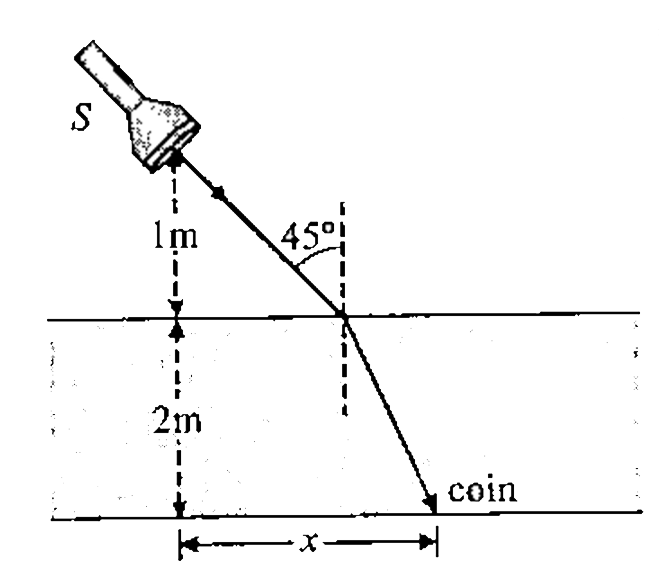From the following which can convert an incident light from a point source into parallel beam?
Concave mirror and concave lens both
Concave mirror and convex lens both
Convex mirror and convex lens both
Perpendicularly placed two plane mirrors
The correct Answer is:B
To solve the question of which optical device can convert incident light from a point source into a parallel beam, we will analyze the options provided.
1. Understanding the Concept:
- A point source emits light in all directions. When this light passes through certain optical devices, it can be transformed into a parallel beam.
2. Analyzing the Options:
- Option 1: Concave Mirror and Convex Lens:
- A concave mirror can take light rays from a point source and reflect them to form parallel rays when the object is placed at its focus.
- A convex lens can take light rays from a point source and refract them to form parallel rays when the object is placed at its focal point.
- Option 2: Concave Mirror and Concave Lens:
- A concave lens diverges light rays, so it cannot produce a parallel beam from a point source.
- Option 3: Convex Mirror and Convex Lens:
- A convex mirror diverges light rays, so it cannot produce a parallel beam from a point source.
- Option 4: Perpendicular Plane to Plane Mirror:
- A plane mirror reflects light but does not convert it into a parallel beam from a point source.
3. Conclusion:
- The only combination that can convert incident light from a point source into a parallel beam is Concave Mirror and Convex Lens.
Final Answer:
The correct answer is Concave Mirror and Convex Lens.
---
- A point source emits light in all directions. When this light passes through certain optical devices, it can be transformed into a parallel beam.
- Option 1: Concave Mirror and Convex Lens:
- A concave mirror can take light rays from a point source and reflect them to form parallel rays when the object is placed at its focus.
- A convex lens can take light rays from a point source and refract them to form parallel rays when the object is placed at its focal point.
- Option 2: Concave Mirror and Concave Lens:
- A concave lens diverges light rays, so it cannot produce a parallel beam from a point source.
- Option 3: Convex Mirror and Convex Lens:
- A convex mirror diverges light rays, so it cannot produce a parallel beam from a point source.
- Option 4: Perpendicular Plane to Plane Mirror:
- A plane mirror reflects light but does not convert it into a parallel beam from a point source.
- The only combination that can convert incident light from a point source into a parallel beam is Concave Mirror and Convex Lens.
The correct answer is Concave Mirror and Convex Lens.
Topper's Solved these Questions
- REFLECTION OF LIGHT, MULTIPLE REFLECTION AND HUMAN EYE AND ITS CAREBOOK - AGRAWAL EXAM CART BIHARCHAPTER - REFLECTION OF LIGHT, MULTIPLE REFLECTION AND HUMAN EYE AND ITS CAREEXERCISE - IMPORTANT QUESTIONS
70 Videos
- REFLECTION OF LIGHT, MULTIPLE REFLECTION AND HUMAN EYE AND ITS CAREBOOK - AGRAWAL EXAM CART BIHARCHAPTER - REFLECTION OF LIGHT, MULTIPLE REFLECTION AND HUMAN EYE AND ITS CAREEXERCISE - IMPORTANT QUESTIONS
70 Videos
- PRACTICE SET 03BOOK - AGRAWAL EXAM CART BIHARCHAPTER - PRACTICE SET 03EXERCISE - SECTION - IV (GENERAL SCIENCE)
34 Videos
- SOUND (LOUDNESS, PITCH, AUDIBLE AND INAUDIBLE SOUND) AND HUMAN EARSBOOK - AGRAWAL EXAM CART BIHARCHAPTER - SOUND (LOUDNESS, PITCH, AUDIBLE AND INAUDIBLE SOUND) AND HUMAN EARSEXERCISE - IMPORTANT QUESTIONS
80 Videos
Similar Questions
The wavefront coming from a point source of light is a ______wavefront.
View SolutionA coin lies on the bottom of a lake 2 m deep at a horizontal distance x from the spot light S which is a source of thin parallel beam of light situated 1 m above the surface of the liquid of refractive index p= as shown in figure. The liquid height is 2m. Find x so that a narrow beam of light from S when incident on the liquid surface at incidence angle 45∘ fells directly on the coin

View Solution
Knowledge Check
Which of the following is correct for light diverging from a point source ?
AThe intensity decreases in proporation for the distance squared.BThe wavefront is parabolic.CThe intensity at the wavelength does not depend on the distance.DNone of these.For light diverging from a point source
Athe wavefront in spherical.Bthe intensity decreases in proportion to the distance squared.Cthe wavefront is parabolic.Dthe intensity at the wavefront does not depend on the distance.Which of the following can make a parallel beam of light from a point source is incident on it ?
AConcave mirror as well as convex lensBConvex mirror as well as concave lensCTwo plane mirrors placed at 90∘ to each otherDConcave mirror as well as concave lens
Which of the following can make a parallel beam of light from a point source is incident on it ?
View SolutionWhich of the following can make a parallel beam of light when light from a point source is incident on it
View SolutionWhich of the following can make a parallel beam of light when light from a point source is incident on it?
View SolutionAt a finite distance from the source, a point source of light produces
View SolutionAssertion L A spherical wavefront is produced by a point source of light .
Reason : It is because, the locus of al points, which are equidistant from the point source, is a sphere.
View Solution
